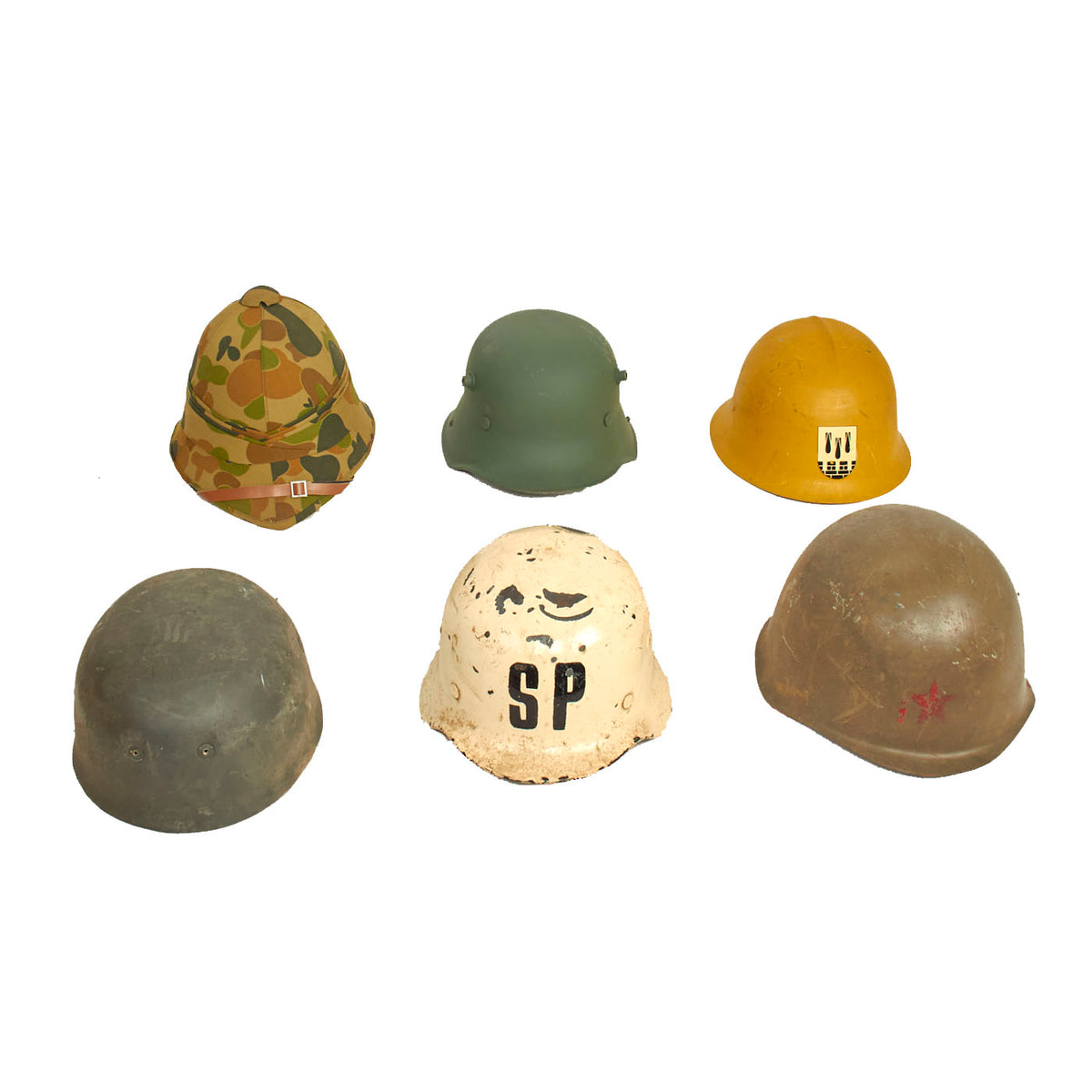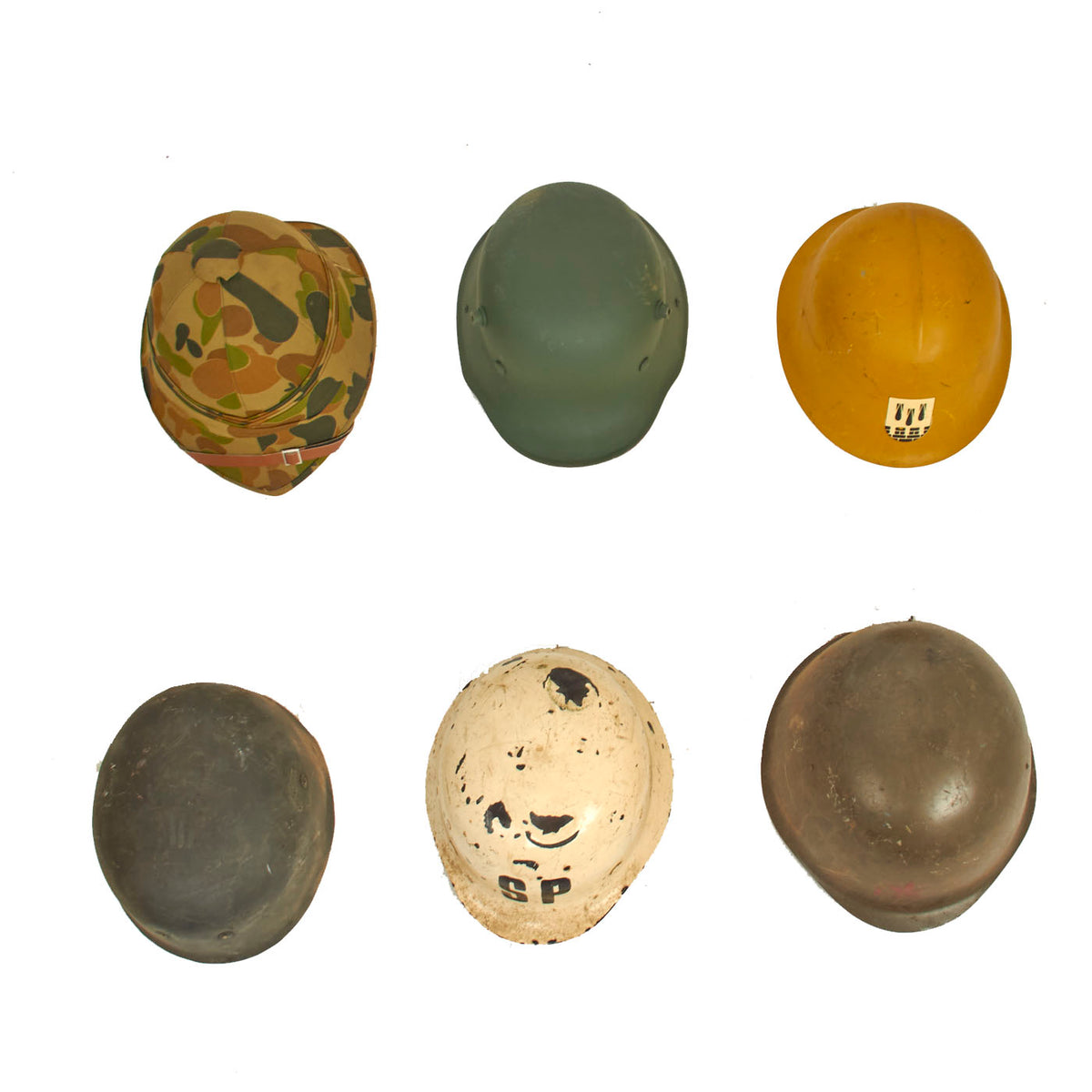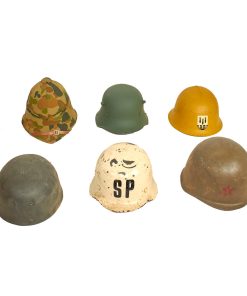Original And Reproduction British, German, Finnish, Swedish and Czech Helmet Lot – 6 Items Original Items
$ 295,00 $ 118,00
Original and New Items: Only One Lot of 6 Available. A combat helmet or battle helmet is a type of helmet. It is a piece of personal armor designed specifically to protect the head during combat. Modern combat helmets are mainly designed to protect from shrapnel and fragments, offer some protection against small arms, and offer a mounting point for devices such as night vision goggles and communications equipment.
All helmets vary in condition and are complete with liners except for the German paratrooper helmet. All helmets are original except for the British pith helmet, paratrooper helmet and the WWI German helmet. Please see photos for the finer details. This is an amazing lot and is perfect for the young collector looking for a place to start!
Helmets are among the oldest forms of personal protective equipment and are known to have been worn by the Akkadians/Sumerians in the 23rd century BC, Mycenaean Greeks since the 17th century BC, the Assyrians around 900 BC, ancient Greeks and Romans, throughout the Middle Ages, and up to the end of the 17th century by many combatants. Their materials and construction became more advanced as weapons became more and more powerful. Initially constructed from leather and brass, and then bronze and iron during the Bronze and Iron Ages, they soon came to be made entirely from forged steel in many societies after about 950 AD. At that time, they were purely military equipment, protecting the head from cutting blows with swords, flying arrows, and low-velocity musketry. Iron helmets were deployed into the cavalry of the Mali Empire to protect the cavalrymen and their mount.
Military use of helmets declined after 1670, and rifled firearms ended their use by foot soldiers after 1700 but the Napoleonic era saw ornate cavalry helmets reintroduced for cuirassiers and dragoons in some armies which continued to be used by French forces during World War I as late as 1915.
World War I and its increased use of artillery renewed the need for steel helmets, with the French Adrian helmet and the British Brodie helmet being the first modern steel helmets used on the battlefield, soon followed by the adoption of similar steel helmets, such as the Stahlhelm by the other warring nations. Such helmets offered protection for the head from shrapnel and fragments.
Today’s militaries often use high quality helmets made of ballistic materials such as Kevlar and Twaron, which offer improved protection. Some helmets also have good non-ballistic protective qualities, against threats such as concussive shock waves from explosions.
Many of today’s combat helmets have been adapted for modern warfare requirements and upgraded with STANAG rails to act as a platform for mounting cameras, video cameras and VAS Shrouds for the mounting of night vision goggles (NVG) and monocular night vision devices (NVD).
Beginning in the early 20th century, combat helmets have often been equipped with helmet covers to offer greater camouflage. There have been two main types of covers—mesh nets were earlier widely used, but most modern combat helmets use camouflage cloth covers instead.
By the late 20th century, starting in the 1970s and 1980s, new materials such as Kevlar and Twaron began replacing steel as the primary material for combat helmets, in an effort to improve weight, ballistics protection, and protection against head injuries caused by blasts. This practice still continues into the 21st century, with further advancement and refinements in the fibers used, design and shape of the helmet, and increased modularity. Early helmet systems of this new design are the American PASGT, the Spanish MARTE, the Italian SEPT-2 PLUS, and British Mk6.
Fast Shipping with Professional Packaging
Thanks to our longstanding association with UPS FedEx DHL, and other major international carriers, we are able to provide a range of shipping options. Our warehouse staff is expertly trained and will wrap your products according to our exact and precise specifications. Prior to shipping, your goods will be thoroughly examined and securely secured. We ship to thousands clients each day across multiple countries. This shows how we're dedicated to be the largest retailer on the internet. Warehouses and distribution centres can be located throughout Europe as well as the USA.
Note: Orders with more than one item will be assigned a processing date depending on the item.
Before shipping before shipping, we'll conduct a thorough inspection of the items you have ordered. Today, the majority of orders will be delivered within 48 hours. The delivery time will be between 3-7 days.
Returns
The stock is dynamic and we cannot completely manage it because multiple stakeholders are involved, including our factory and warehouse. So the actual stock may alter at any time. It's possible that you may not receive your order once the order has been made.
Our policy is valid for a period of 30 days. If you don't receive the product within 30 days, we are not able to issue a refund or an exchange.
You can only return an item if it is unused and in the same state as the day you received it. You must have the item in its original packaging.
Related products
Uncategorized
Uncategorized
Uncategorized
Uncategorized
Uncategorized
Uncategorized
Australian WWII Owen MK1 Machine Carbine SMG Custom Fabricated Replica with Sling Original Items
Uncategorized
Uncategorized
Band of Brothers ORIGINAL GERMAN WWII Le. F.H. 18 10.5cm ARTILLERY PIECE Original Items
Uncategorized
Uncategorized
Uncategorized
Uncategorized
Uncategorized
Uncategorized
Uncategorized
Uncategorized







































































